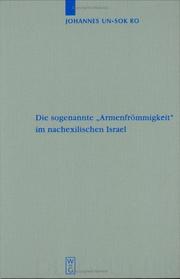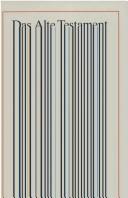| Listing 11 - 16 of 16 | << page >> |
Sort by
|
Book
ISBN: 9780814681626 081468162X 9780814681879 Year: 2017 Publisher: Collegeville, Minnesota Liturgical Press
Abstract | Keywords | Export | Availability | Bookmark
 Loading...
Loading...Choose an application
- Reference Manager
- EndNote
- RefWorks (Direct export to RefWorks)
This volume offers a womanist and feminist analysis of the books of Nahum, Habakkuk, and Zephaniah, attending to translation and textual issues, use of power and agency, and constructions of gender and its significance for the real and metaphorical women in the texts. The unit on Nahum takes an unflinching look at God's role and rhetoric in the rape of Nineveh and considers implications for the women of Nineveh and Israel and for contemporary readers. Habakkuk is read employing a womanist stratagem, talking back to God. The section on Zephaniah explores the racialized history of interpreting "Cushi" in Zephaniah's genealogy and the figures of Daughter Zion/Jerusalem. The commentary also assesses these texts as scriptures of synagogue and church, their use and utility. A Jewish feminist reading and womanist hermeneutic accompanies each biblical book.
224.94 --- 224.95 --- 224.96 --- 224.96 Sophonia. Zephaniah --- Sophonia. Zephaniah --- 224.95 Habakuk --- Habakuk --- 224.94 Nahum --- Nahum --- Bible. --- Nahum (Book of the Old Testament) --- Sofonia (Book of the Bible) --- Zefanja (Book of the Bible) --- Zephaniah (Book of the Bible) --- Habakkuk (Book of the Old Testament) --- Ḥavaḳuḳ (Book of the Old Testament) --- Feminist criticism.

ISBN: 3110174715 3111799387 3110864797 9783110174717 Year: 2002 Volume: 322 Publisher: Berlin Gruyter
Abstract | Keywords | Export | Availability | Bookmark
 Loading...
Loading...Choose an application
- Reference Manager
- EndNote
- RefWorks (Direct export to RefWorks)
Der Band untersucht die Thematisierung von "Armut" in Qumran, im Psalter sowie in prophetischen Texten (Jes, Jer und Zef) und die sich darin abzeichnenden religiösen Konfliktlagen. Dabei wird die in neueren Arbeiten verstärkt vertretene These überprüft, daß für die sogenannte "Armenfrömmigkeit" eine Art Armenbewegung in ausgebeuteten, völlig verarmten und verelendeten Unterschichtskreisen zu veranschlagen sei. Die vorliegende Veröffentlichung kommt zu dem Ergebnis, daß das "Armsein" eine religiös fundierte Existenzweise ist. Die Defizite, über die geklagt wird, sind nicht materieller Art. Da mehrfach theologische Positionen und Oppositionen der Armenfrömmigkeit an die Qumran-Essener erinnern, ist es keineswegs abwegig, dort geradezu eine Strukturparallele zur Armenfrömmigkeit wahrzunehmen und geistes- bzw. theologiegeschichtliche Zusammenhänge herzustellen. This study examines the thematisation of "poverty" in the Qumran, the Psalms and in the Prophets (Isaiah, Jeremiah, Zephaniah) and the emerging religious conflict situation. It tests the thesis presented to an increasing degree in recent research that the so-called "piety of the poor" pre-supposes some "paupers' movement" among the exploited and destitute under-classes. The author concludes that "poverty" is a form of existence with a religious foundation. The deficits which are bemoaned are not material in nature. As a number of the theological positions and oppositions of the piety of the poor are reminiscent of the Qumran Essenes, it is not unreasonable to see there a structural parallel to the piety of the poor and to postulate historical connections of an intellectual and a theological nature.
Bible OT --- 223.3 --- 224.2 --- 224.96 --- Psalmen --- Jesaja. Isaias --- Sophonia. Zephaniah --- 224.96 Sophonia. Zephaniah --- Poverty --- Biblical teaching --- Palestine --- Bible. Old Testament --- Criticism, interpretation, etc --- Poverty in the Bible. --- Piety --- Biblical teaching. --- Bible. --- Criticism, interpretation, etc. --- Christian life --- Spiritual life --- Antico Testamento --- Hebrew Bible --- Hebrew Scriptures --- Kitve-ḳodesh --- Miḳra --- Old Testament --- Palaia Diathēkē --- Pentateuch, Prophets, and Hagiographa --- Sean-Tiomna --- Stary Testament --- Tanakh --- Tawrāt --- Torah, Neviʼim, Ketuvim --- Torah, Neviʼim u-Khetuvim --- Velho Testamento
Book
ISBN: 3460047011 9783460047013 Year: 1996 Volume: 170 Publisher: Stuttgart Katholisches Bibelwerk
Abstract | Keywords | Export | Availability | Bookmark
 Loading...
Loading...Choose an application
- Reference Manager
- EndNote
- RefWorks (Direct export to RefWorks)
Bible --- Criticism, interpretation, etc --- 224.96 --- #GGSB: Exegese O.T. --- #GGSB: Profeten --- #GGSB: Tekstkritiek O.T. --- #GROL:SEMI-22<08> Stut 170 --- #GROL:SEMI-224.6 Sefa --- Sophonia. Zephaniah --- 224.96 Sophonia. Zephaniah --- #GGSB: Exegese O.T --- #GGSB: Tekstkritiek O.T --- Bible. --- Sofonia (Book of the Bible) --- Zefanja (Book of the Bible) --- Zephaniah (Book of the Bible) --- Criticism, interpretation, etc. --- Exegese O.T --- Profeten --- Tekstkritiek O.T

ISBN: 3525512287 Year: 2004 Publisher: Göttingen Vandenhoeck & Ruprecht
Abstract | Keywords | Export | Availability | Bookmark
 Loading...
Loading...Choose an application
- Reference Manager
- EndNote
- RefWorks (Direct export to RefWorks)
224.94 --- 224.95 --- 224.96 --- 224.96 Sophonia. Zephaniah --- Sophonia. Zephaniah --- 224.95 Habakuk --- Habakuk --- 224.94 Nahum --- Nahum --- Bible. --- Sofonia (Book of the Bible) --- Zefanja (Book of the Bible) --- Zephaniah (Book of the Bible) --- Nahum (Book of the Old Testament) --- Habakkuk (Book of the Old Testament) --- Ḥavaḳuḳ (Book of the Old Testament) --- Bible OT. Twelve prophets. Nahum --- Bible OT. Twelve prophets. Habakkuk --- Bible OT. Twelve prophets. Zephaniah
Book
ISBN: 9783110228564 9783110228571 3110228564 Year: 2011 Volume: 414 Publisher: Berlin Boston De Gruyter
Abstract | Keywords | Export | Availability | Bookmark
 Loading...
Loading...Choose an application
- Reference Manager
- EndNote
- RefWorks (Direct export to RefWorks)
Gentiles in the Old Testament --- Ethnicity in the Bible --- Jews --- Identity --- Bible --- Criticism, interpretation, etc --- 224.62 --- 224.91 --- 224.94 --- 224.96 --- Joël --- Abdia. Obadiah --- Nahum --- Sophonia. Zephaniah --- 224.96 Sophonia. Zephaniah --- 224.94 Nahum --- 224.91 Abdia. Obadiah --- 224.62 Joël --- Identity, Jewish --- Jewish identity --- Jewishness --- Jewish law --- Jewish nationalism --- Ethnic identity --- Race identity --- Legal status, laws, etc. --- Bible. --- Sofonia (Book of the Bible) --- Zefanja (Book of the Bible) --- Zephaniah (Book of the Bible) --- Abdias (Book of the Old Testament) --- Obadiah (Book of the Old Testament) --- Obadja (Book of the Old Testament) --- Obadya (Book of the Old Testament) --- ʻOvadyah (Book of the Old Testament) --- Nahum (Book of the Old Testament) --- Joel (Book of the Old Testament) --- Criticism, interpretation, etc. --- Jews - Identity
Book
ISBN: 9783110646214 3110646218 9783110650266 9783110649949 Year: 2019 Volume: 517 Publisher: Berlin Boston
Abstract | Keywords | Export | Availability | Bookmark
 Loading...
Loading...Choose an application
- Reference Manager
- EndNote
- RefWorks (Direct export to RefWorks)
Although many scholars recognize literary similarities between Hosea, Amos, Micah, and Zephaniah, defining the compositional relationship between these texts remains a matter of debate. Following the scholarly trajectory of exploring the compositional relationship between the Twelve prophets, several scholars argue that these four prophetic texts formed a precursory collection to the Book of the Twelve. Yet even among advocates for this ‘Book of the Four’ there remain differences in defining the form and function of the collection. By reexamining the literary parallels between these texts, Werse shows how different methodological convictions have led to the diverse composition models in the field today. Through careful consideration of emerging insights in the study of deuteronomism and scribalism, Werse provides an innovative composition model explaining how these four texts came to function as a collection in the wake of the traumatic destruction of Jerusalem. This volume explores a historic function of these prophetic voices by examining the editorial process that drew them together.
Prophecy --- 224.6 --- 224.61 --- 224.63 --- 224.96 --- 224.96 Sophonia. Zephaniah --- Sophonia. Zephaniah --- 224.63 Amos --- Amos --- 224.61 Hosea --- Hosea --- 224.6 Kleine profeten--(algemeen) --- 224.6 Petits prophetes--(general) --- Kleine profeten--(algemeen) --- Petits prophetes--(general) --- Forecasting --- Bible. --- Bible --- Sofonia (Book of the Bible) --- Zefanja (Book of the Bible) --- Zephaniah (Book of the Bible) --- Micah (Book of the Old Testament) --- Micheas (Book of the Old Testament) --- Mikhah (Book of the Old Testament) --- Miqueas (Book of the Old Testament) --- Amos (Book of the Old Testament) --- Amosŭ (Book of the Old Testament) --- Hosea (Book of the Old Testament) --- Hosheʻa (Book of the Old Testament) --- Osee (Book of the Old Testament) --- Osīi︠a︡ (Book of the Old Testament) --- Holy Scriptures (Bible) --- Criticism, interpretation, etc. --- Criticism, Redaction.
| Listing 11 - 16 of 16 | << page >> |
Sort by
|

 Search
Search Feedback
Feedback About UniCat
About UniCat  Help
Help News
News